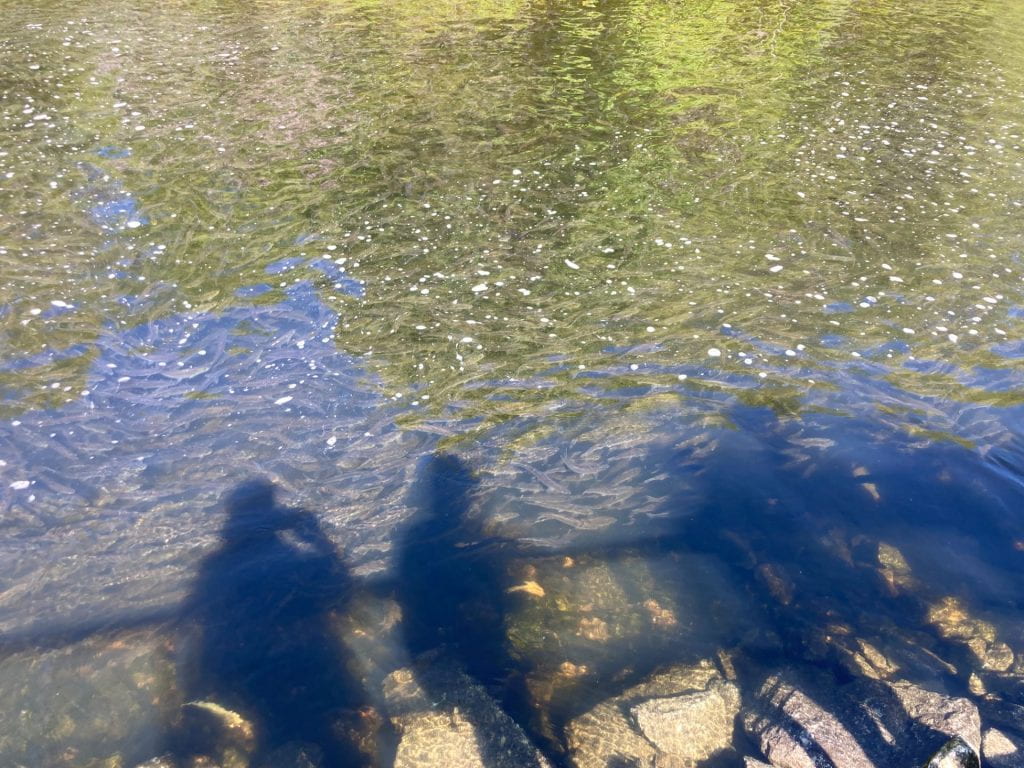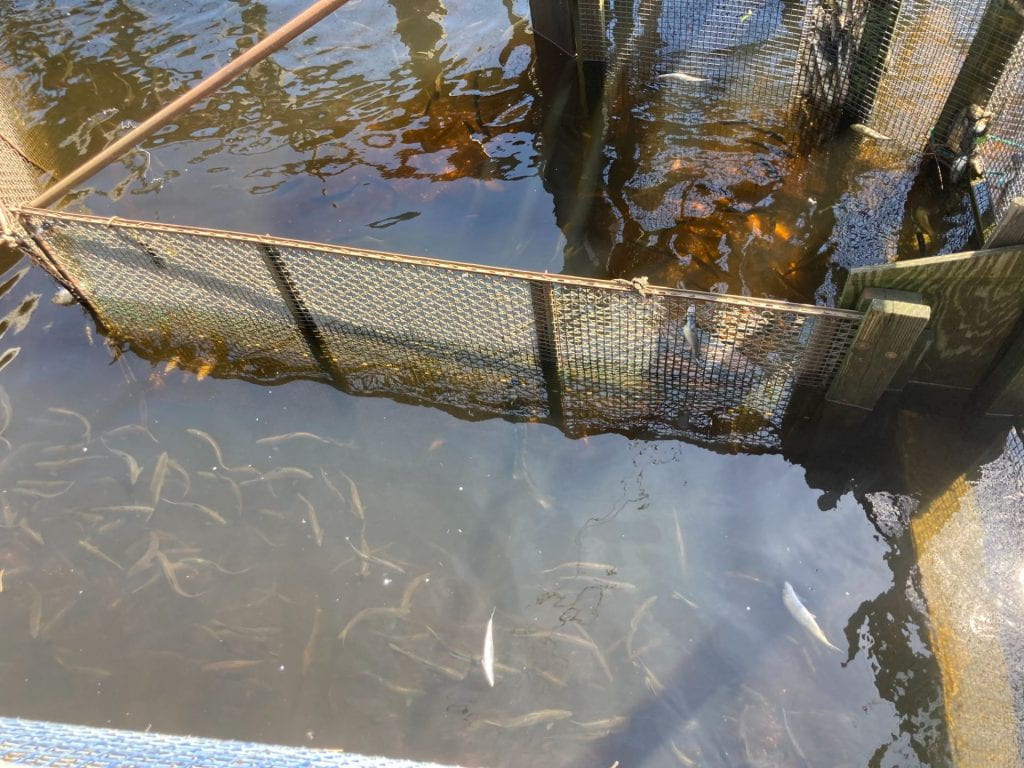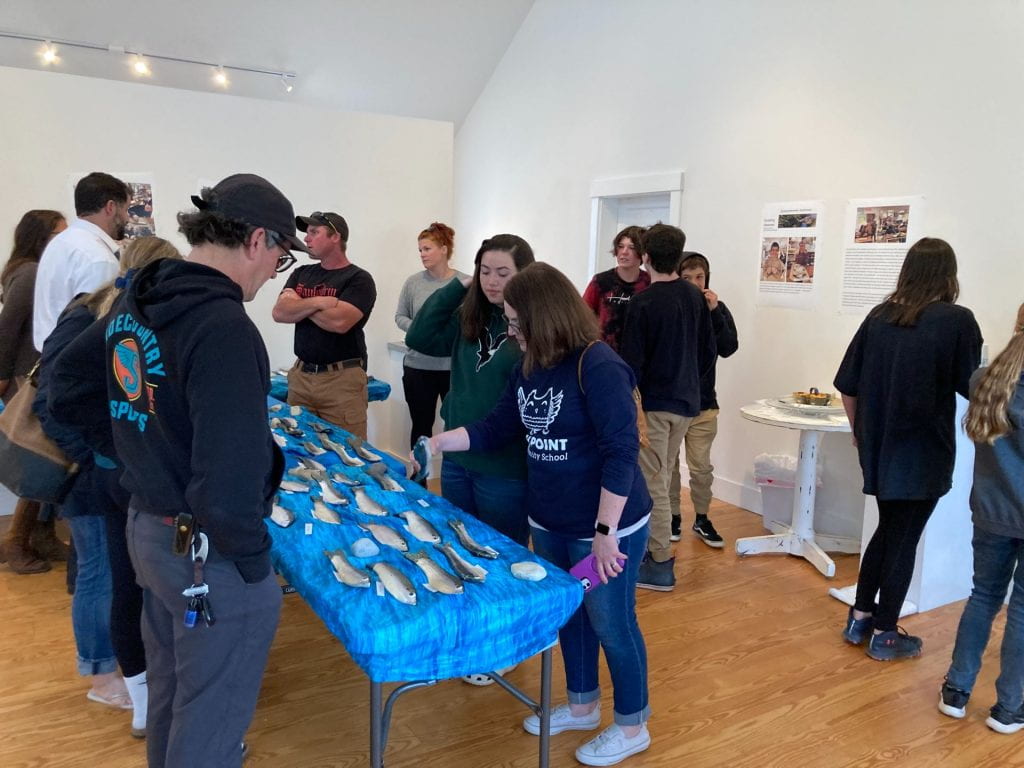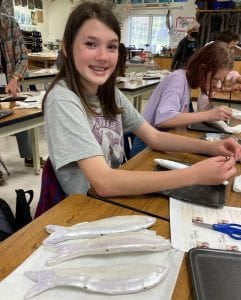A beautiful day was highlighted by the amazing abundance of alewives migrating to Damariscotta Lake. Our goal was to witness a healthy run and get a sense of just how many fish congregate during the annual migration up freshwater streams all over Maine in their instinctual drive to spawn.


 Fish are harvested here during the week. Some of our lobstermen make the trip over here to purchase their bait.
Fish are harvested here during the week. Some of our lobstermen make the trip over here to purchase their bait.




 We also visited the Warren Fish Trap where St. George River alewives are harvested at the head of the tide in Warren. Harvest rights were given to towns at the head of the tide, and Warren was granted this right in 1802 by the state of Massachusetts. It was a big surprise to see a striped bass in the trap with the alewives!
We also visited the Warren Fish Trap where St. George River alewives are harvested at the head of the tide in Warren. Harvest rights were given to towns at the head of the tide, and Warren was granted this right in 1802 by the state of Massachusetts. It was a big surprise to see a striped bass in the trap with the alewives!
 “I thought the fish were cool. I was surprised to see so many.You couldn’t even see the bottom because it was all fish, all going different directions.” Cam
“I thought the fish were cool. I was surprised to see so many.You couldn’t even see the bottom because it was all fish, all going different directions.” Cam
“This morning we went to the fish ladder and the fish trap. The fish ladder was very interesting and not what I expected. I have never seen that many fish in one place. It looked like they were going to fall out of the water. There were so many. I noticed that the fish made the water black. You could only see the individual fish when you got up close, but when you were far away the water was just dark. There were many more fish than I expected and they were much more dense than I thought they would be. I thought it was very interesting how they were swimming. They would randomly stop and leave the group and then join again in a different spot. It looked like they were playing tag. And seeing this helped me understand how the fish travel better. I really enjoyed this trip and I hope I will get to go here again.” Madelyn “There were definitely more fish than I expected…When we walked the water was filled with alewives. I found how many there are interesting. I learned how they actually travel together upstream and how it actually works.” Violet
“There were definitely more fish than I expected…When we walked the water was filled with alewives. I found how many there are interesting. I learned how they actually travel together upstream and how it actually works.” Violet
 “We went to the Damariscotta fish ladder and the Warren fish trap. The alewives at the fish ladder that we saw were very cool and it was super interesting the way they swam in their school. The alewives at the fish trap were pretty awesome. I noticed that from the top and when alewives are swimming they look like little baby sharks. I have been to the fish ladder before so I kind of knew how many fish were going to be there but there was definitely more than I expected. I understand how the alewives travel and move upstream better after this experience. I learned that a lot of alewives die at the fish ladder but yet there are still so many and I didn’t know that before this field trip.” Karly
“We went to the Damariscotta fish ladder and the Warren fish trap. The alewives at the fish ladder that we saw were very cool and it was super interesting the way they swam in their school. The alewives at the fish trap were pretty awesome. I noticed that from the top and when alewives are swimming they look like little baby sharks. I have been to the fish ladder before so I kind of knew how many fish were going to be there but there was definitely more than I expected. I understand how the alewives travel and move upstream better after this experience. I learned that a lot of alewives die at the fish ladder but yet there are still so many and I didn’t know that before this field trip.” Karly “I thought the fish in Damariscotta and Warren were very cool and persistent. I have never been there before so I didn’t really know what to expect. Although I was kind of expecting some fish to be going under the big bridge. I wondered a few things about the fish. I wondered if the fish knew they could either go to get harvested or to their spawning ground. I also wondered if they felt sad when they swam past the dead alewives. Something else I found interesting was the diversity of wildlife that was there. There were seagulls, sunfish, periwinkles, bald eagles, elvers, and of course alewives. This experience has helped me to better understand why people were so sad when our run disappeared. It also makes me think hard about what we could or could have done to fix our run.” Trinity
“I thought the fish in Damariscotta and Warren were very cool and persistent. I have never been there before so I didn’t really know what to expect. Although I was kind of expecting some fish to be going under the big bridge. I wondered a few things about the fish. I wondered if the fish knew they could either go to get harvested or to their spawning ground. I also wondered if they felt sad when they swam past the dead alewives. Something else I found interesting was the diversity of wildlife that was there. There were seagulls, sunfish, periwinkles, bald eagles, elvers, and of course alewives. This experience has helped me to better understand why people were so sad when our run disappeared. It also makes me think hard about what we could or could have done to fix our run.” Trinity














































